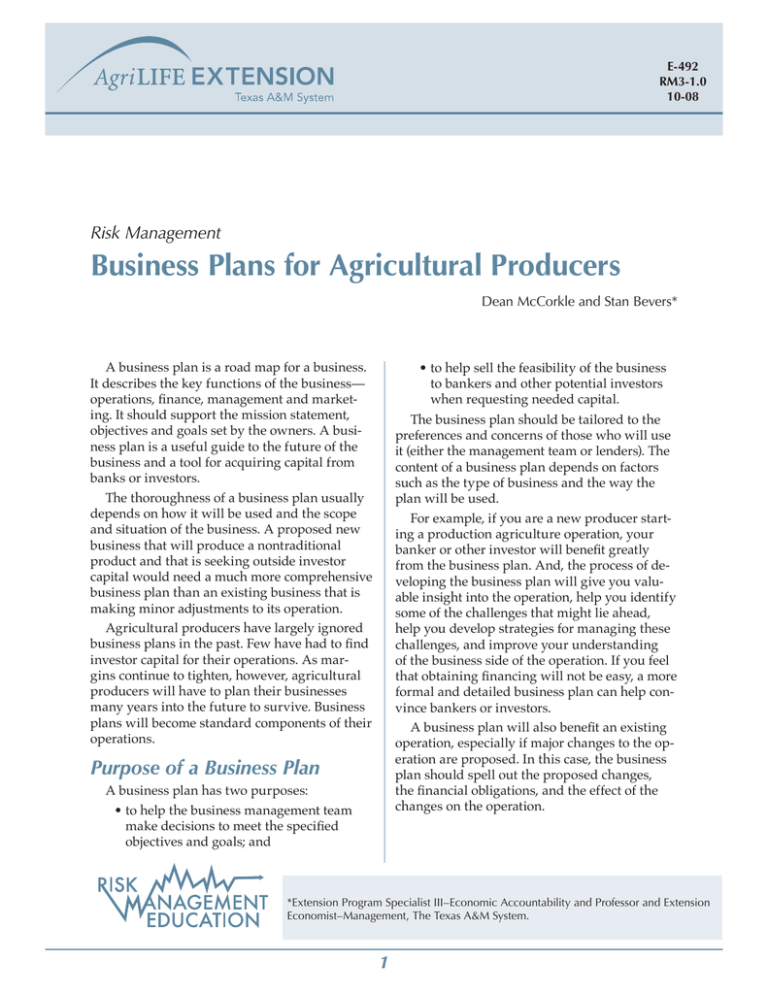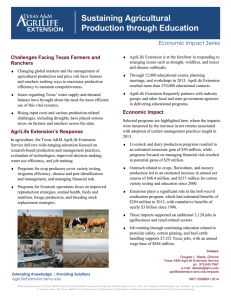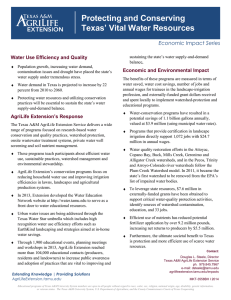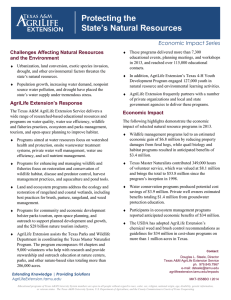Business Plans for Agricultural Producers Risk Management Dean McCorkle and Stan Bevers*
advertisement

E-492 RM3-1.0 10-08 Risk Management Business Plans for Agricultural Producers Dean McCorkle and Stan Bevers* A business plan is a road map for a business. It describes the key functions of the business— operations, finance, management and marketing. It should support the mission statement, objectives and goals set by the owners. A business plan is a useful guide to the future of the business and a tool for acquiring capital from banks or investors. The thoroughness of a business plan usually depends on how it will be used and the scope and situation of the business. A proposed new business that will produce a nontraditional product and that is seeking outside investor capital would need a much more comprehensive business plan than an existing business that is making minor adjustments to its operation. Agricultural producers have largely ignored business plans in the past. Few have had to find investor capital for their operations. As margins continue to tighten, however, agricultural producers will have to plan their businesses many years into the future to survive. Business plans will become standard components of their operations. •to help sell the feasibility of the business to bankers and other potential investors when requesting needed capital. The business plan should be tailored to the preferences and concerns of those who will use it (either the management team or lenders). The content of a business plan depends on factors such as the type of business and the way the plan will be used. For example, if you are a new producer starting a production agriculture operation, your banker or other investor will benefit greatly from the business plan. And, the process of developing the business plan will give you valuable insight into the operation, help you identify some of the challenges that might lie ahead, help you develop strategies for managing these challenges, and improve your understanding of the business side of the operation. If you feel that obtaining financing will not be easy, a more formal and detailed business plan can help convince bankers or investors. A business plan will also benefit an existing operation, especially if major changes to the operation are proposed. In this case, the business plan should spell out the proposed changes, the financial obligations, and the effect of the changes on the operation. Purpose of a Business Plan A business plan has two purposes: •to help the business management team make decisions to meet the specified objectives and goals; and *Extension Program Specialist III–Economic Accountability and Professor and Extension Economist–Management, The Texas A&M System. 1 tion also should be included. Describe the duties, responsibilities and decision-making authority of managers and other employees. If bankers or investors will see the business plan, they will be interested in who is involved, who is doing what, and what their qualifications and responsibilities are. Components of a Business Plan While the components of a business plan may vary, complete business plans usually contain the following: •Business description History and location Products and services Organizational structure Resource inventory ZZ Human ZZ Land ZZ Equipment ZZ capital ZZ Commodities ZZ Natural resources Strengths, weaknesses, opportunities and threats (SWOT) •Mission statement Mission Statement, Objectives and Goals A business plan must define why the business exists and where the management wants it to be in the future. A mission statement is a broad expression of the business’s purpose. Every member of the management team should be involved in writing the mission statement. An effective mission statement is the foundation for determining objectives and goals and steering the business in the proper direction. The objectives and goals can relate to production, production costs, debt ratios, risk management, expansion, bringing a partner into the business, or any other aspect of the business. Objectives define what the operation will look like in the future, while goals are targets to be met in order to achieve the objectives and ultimately fulfill the mission statement. Many business planning publications recommend the setting of SMART goals—goals that are specific, measurable, attainable, rewarding, and that are associated with a specific timeframe. The following diagram illustrates the relationships among the mission statement, objectives and goals. Strategies and tactics, the top two layers, are the final steps to achieving your mission. Strategies make up your overall plan for achieving long-range objectives and goals, while tactics are the ways of accomplishing your strategies through day-to-day operations. •Objectives and goals •Production plan •Financial plan •Market plan •Legal and liability issues Insurance Succession and estate planning Business Description and Organization The first portion of the business plan is an overview of the operation. It describes the history and location of the business, the products produced and/or services provided, the organizational structure, and resources the business has and needs. It also summarizes the business’s strengths, weaknesses and opportunities, and threats the business may face. Organizational structure explains: 1) whether the business is a sole proprietorship, limited or general partnership, corporation, or other form of organization; and 2) who comprises the management team. The management team should include the family members involved, any hired employees, the lender, and any hired consultants. Each should be listed in the plan. The number of employees and their compensa- 2 Production Plan •the length of the loan(s) and the interest rates; The production plan conveys the type and quantity of commodities to be produced, projected for 3 years into the future. The production plan should be easy for the reader to follow. These same figures are included in the financial plan. Crop production plans should include the estimated acreage for each crop each year (crop rotation), and an estimated yield for each crop. Estimated production levels can then be combined with estimated prices to generate some of the figures needed for the financial component. Livestock operations will include more variables, such as size of the herd, cull rates, weaning rates, weaning weights, rates of gain, purchase prices, sales prices, etc. If there is a replacement herd involved, as with a cow herd or swine farrowing enterprise, the production assumptions for the replacement herd need to be spelled out separately from the breeding herd. The production plan should be defined for a minimum of 3 years. Although changes will occur, these projections show where the business is going and whether it can reach its goals and objectives. •the financial risks associated with the business; and •the strategies you will use to minimize these risks. These are key issues the owners and/or managers need to think about and that lenders and investors will be looking for. One simple approach to analyzing risks and business feasibility is to look at the effect of varying levels of income, such as a 10, 20 and 30 percent increase or decrease in gross income. The income statement and balance sheet are usually projected on an end-of-year, annual basis, while the cash flow statement is usually presented on a monthly basis. For in-depth information on these financial statements, refer to the additional readings list. Market Plan The market plan should not be confused with an annual marketing plan a producer uses to market products or services. The business plan should contain a marketing plan for the first year of the projection period. The market plan section should give information about the market structure for the commodities you plan to produce and describe how your product fits into the market. The structure and content of the market plan will depend somewhat on the commodity. The plan should give some analysis of the current market situation and what you think the market will be like in the next 3 to 5 years. This type of long-range market analysis can address projected U.S. production, total supply and demand, federal farm programs, cycles and other factors. Researching what market analysts are saying about current and future market conditions can help in developing this portion of the market plan. If you produce commodities such as cotton and feeder cattle that are marketed through major market channels, the market plan also should explain the strategies you will use to minimize price risk. These strategies can involve futures, options, marketing pools, forward contracts or any combination of these. Financial Plan The primary purpose of the financial plan is to show whether or not the business is feasible. The financial plan typically includes 3 years of projected financial statements, including the income statement, the cash flow statement and the balance sheet. This information should be tied closely to the production plan figures. An existing business will have actual financial statements for the past 2 years, which helps put the projected financial statement into perspective by showing how the business has performed in the past. The financial plan also should include: •the amount of money to be borrowed and the timing of loans; •the specific ways borrowed money will be used (operating expenses, land, equipment, etc.); 3 Businesses that produce fruits or vegetables, specialty products, or other commodities not marketed through major channels may have to develop markets. In this case the market plan should define potential buyers (target market), distribution channels and middlemen. It should discuss potential pricing mechanisms, such as contracts. Beef producers who produce specialty beef products or participate in a beef alliance should address this aspect of the market program. As mentioned above, the market plan section should include a detailed marketing plan for the first year of the projection period. An annual marketing plan, which uses information from other parts of the business plan, involves determining marketing objectives and goals, developing your personal market outlook for the year, identifying available marketing tools you feel comfortable using, determining target price and date triggers, and identifying the strategies you will use to accomplish the marketing objectives and goals you have set. Other areas to address are succession planning and estate planning. Succession planning is the means by which ownership and management of the operation will be transferred to someone else. The succession plan should specify when this will occur, or what events (such as retirement or death) will trigger the transfer. If the business will cease operations at some point in the future, the business needs to have a liquidation plan. Planning ahead for this important event will ease the transition. The estate plan is usually closely related to the succession plan. It involves planning for the transfer of property to your beneficiaries. Estate planning can be a very involved process, but in the business plan you need only summarize the objectives of your estate plan and the estate planning vehicles you will use, such as wills and/or trusts. References “Focus on Success: Strategies and Tactics.” Doane’s Agricultural Report, Vol. 62, No. 2, January 8, 1999. Legal and Liability Issues For Additional Reading This portion of the business plan should define risks the business might face. The plan should outline insurance needs, legal liability, and the succession of the operation. The risks businesses face generally fall into these broad categories: loss of key employees; legal liability; and property loss. Risks are usually managed through the use of insurance. There are several types of insurance that provide financial protection. The structure of a business also can be used to manage risks. The business plan should address the strategies you use for managing risks. A bank or investor will have a keen interest in this area. Small Business Administration. 1-800-827-5722. http://www.sba.gov/starting/ Wilson, Troy D. and David M. Kohl. “Business Planning—A Road Map for Success.” Farm Business Management Update. Virginia Cooperative Extension Service. August 1997. Other publications in this Risk Management Education series published by the Texas AgriLife Extension Service. http://agecoext.tamu.edu/resources/library/riskmanagement-curriculum-guide.html 4 Partial funding support has been provided by the Texas Corn Producers, Texas Farm Bureau, and Cotton Inc.–Texas State Support Committee. Produced by AgriLife Communications, The Texas A&M System Extension publications can be found on the Web at: http://AgriLifeBookstore.org. Visit Texas AgriLife Extension Service at http://AgriLifeExtension.tamu.edu. Educational programs of the Texas AgriLife Extension Service are open to all people without regard to race, color, sex, disability, religion, age, or national origin. Issued in furtherance of Cooperative Extension Work in Agriculture and Home Economics, Acts of Congress of May 8, 1914, as amended, and June 30, 1914, in cooperation with the United States Department of Agriculture. Edward G. Smith, Director, Texas AgriLife Extension Service, The Texas A&M System.






